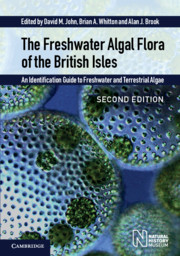 The Freshwater Algal Flora of the British Isles
The Freshwater Algal Flora of the British Isles Book contents
- Frontmatter
- Contents
- The online material (formerly provided in DVD format)
- List of Contributors
- Foreword
- Preface
- Acknowledgements
- Introduction
- Distribution and Ecology
- History of Freshwater Algal Studies in the British Isles
- Field Methods
- Laboratory Methods
- Water Framework Directive
- Cultures of British Freshwater Algae
- Classification
- Key to phyla
- Cyanobacteria (Cyanophyta)
- Phylum Rhodophyta (Red Algae)
- Phylum Euglenophyta (Euglenoids)
- Phylum Cryptophyta (Cryptomonads)
- Phylum Dinophyta (Dinoflagellates)
- Phylum Raphidophyta
- Phylum Haptophyta (Prymnesiophyta)
- Phylum Chrysophyta (Golden Algae)
- Phylum Xanthophyta (Tribophyta) (Yellow-Green Algae)
- Phylum Eustigmatophyta
- Phylum Bacillariophyta (Diatoms)
- Phylum Phaeophyta (Brown Algae)
- Primitive Green Algae (‘PRASINOPHYTA’)
- Phylum Chlorophyta (Green Algae)
- Phylum Glaucophyta
- Glossary
- Standard Form of Authors of Algal Names
- Sources of Illustrations or Material
- References
- Taxonomic Index
- Subject Index
- Plate Saction
- Miscellaneous Endmatter
- Miscellaneous Endmatter
Phylum Raphidophyta
Published online by Cambridge University Press: 12 January 2024
- Frontmatter
- Contents
- The online material (formerly provided in DVD format)
- List of Contributors
- Foreword
- Preface
- Acknowledgements
- Introduction
- Distribution and Ecology
- History of Freshwater Algal Studies in the British Isles
- Field Methods
- Laboratory Methods
- Water Framework Directive
- Cultures of British Freshwater Algae
- Classification
- Key to phyla
- Cyanobacteria (Cyanophyta)
- Phylum Rhodophyta (Red Algae)
- Phylum Euglenophyta (Euglenoids)
- Phylum Cryptophyta (Cryptomonads)
- Phylum Dinophyta (Dinoflagellates)
- Phylum Raphidophyta
- Phylum Haptophyta (Prymnesiophyta)
- Phylum Chrysophyta (Golden Algae)
- Phylum Xanthophyta (Tribophyta) (Yellow-Green Algae)
- Phylum Eustigmatophyta
- Phylum Bacillariophyta (Diatoms)
- Phylum Phaeophyta (Brown Algae)
- Primitive Green Algae (‘PRASINOPHYTA’)
- Phylum Chlorophyta (Green Algae)
- Phylum Glaucophyta
- Glossary
- Standard Form of Authors of Algal Names
- Sources of Illustrations or Material
- References
- Taxonomic Index
- Subject Index
- Plate Saction
- Miscellaneous Endmatter
- Miscellaneous Endmatter
Summary
A small group of single-celled flagellates with two apical flagella differing in function and structure. One flagellum is directed forwards when cells are in motion, often longer than cell and easily visible; the second is thinner, rising close to the first but trailing, possibly acting as a rudder, initially in the apical groove. The large cells have no distinct wall and are often metabolic. Trichocysts or muciferous bodies are normally present in abundance just below the protoplast surface. Pigmented genera have numerous yellow-green, disclike chloroplasts containing chlorophylls a and c as well as several xanthophylls. The cells have oil as a storage product, an eyespot is usually absent, contractile vacuoles are numerous (sometimes in a prominent angular structure near apex), and the nucleus is large, sometimes with an endomembrane cap present.
Named the Chloromonadida by Klebs (1893) but changed to Rhaphidophyta by Bourrelly (1970), who believed the Chloromonadida could be confused with the genus Chloromonas (Chlorophyta, Volvocales). There are some similarities with the Cryptophyta, Pyrrophyta and Euglenophyta, but insufficient to warrant inclusion within any of them. Potter et al. (1997), on the basis of nucleotide sequencing, concluded that the Raphidophyceae are monophyletic, while 28S ribosomal sequencing had previously suggested affinities with the Chrysophyceae (Perasso et al., 1989). There are two families: Vacuolariaceae, containing photosynthetic genera, and the colourless Thaumatostigaceae, whose members have pseudopodia. Only the former family is considered here.
Nine genera are classified in the Raphidophyta and these occur in freshwater and marine habitats. Freshwater species are usually to be found in rather acid waters of some ponds and pools.
Some of the most important references on the phylum are Mignot (1967), Huber-Pestalozzi and Fott (1968), Bourrelly (1970), Spencer (1971),Heywood (1990) and Canter-Lund and Lund (1995).
The cells are extremely delicate and can be disrupted even by gentle pressure on a cover slip. Observation using ‘optical staining’, phase- or anoptral contrast is recommended.
- Type
- Chapter
- Information
- The Freshwater Algal Flora of the British IslesAn Identification Guide to Freshwater and Terrestrial Algae, pp. 275 - 276Publisher: Cambridge University PressPrint publication year: 2021
